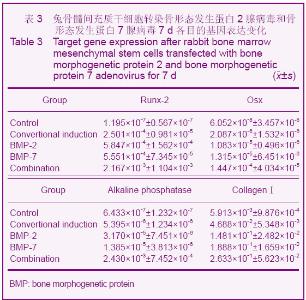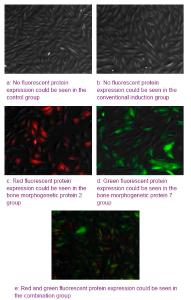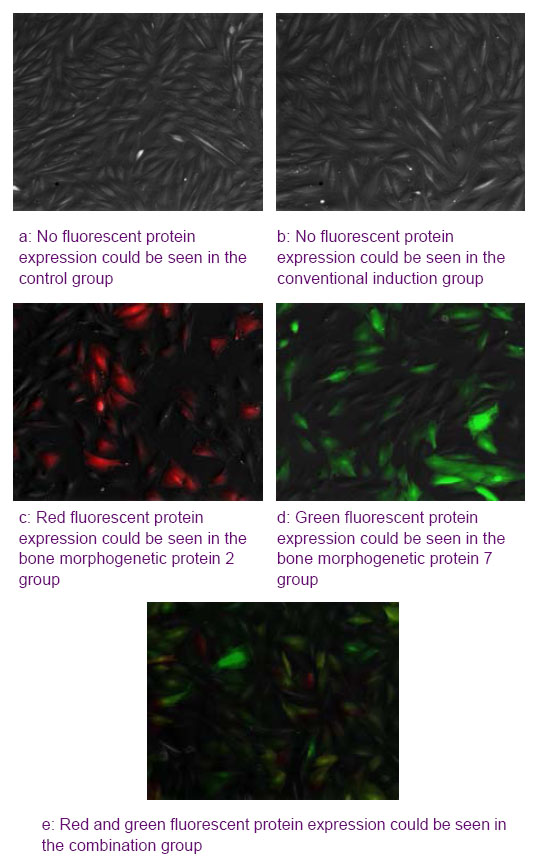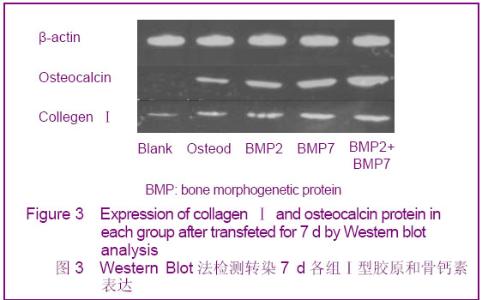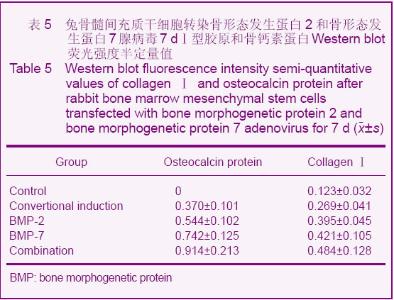Chinese Journal of Tissue Engineering Research ›› 2012, Vol. 16 ›› Issue (49): 9139-9145.doi: 10.3969/j.issn.2095-4344.2012.49.004
Previous Articles Next Articles
Bone morphogenetic protein 2 co-transfected with bone morphogenetic protein 7 forosteogenic differentiation of bone marrow mesenchymal stem cells
Chen Jian1,2, Yuan Wen3, Song Dian-wen3, Hu Kai-meng4, Fan Li-xing4, Liu Hou-qi4
- 1Department of Orthopedics, 2Institute of Clinical Research, Sir Run Run Shaw Hospital, School of Medicine, Zhejiang University, Hangzhou 310016, Zhejiang Province, China; 3Department of Orthopedics, Changzheng Hospital Affiliated to the Second Military Medical University, Shanghai 200003, China; 4Department of Histology and Embryology, the Second Military Medical University, Shanghai 200433, China
-
Received:2012-04-13Revised:2012-06-22Online:2012-12-02Published:2013-01-16 -
Contact:Song Dian-wen, Associate chief physician, Department of Orthopedics, Changzheng Hospital Affiliated to the Second Military Medical University, Shanghai 200003, China songdw@sh163.net -
About author:Chen Jian☆, Doctor, Attending physician, Department of Orthopedics, Institute of Clinical Research, Sir Run Run Shaw Hospital, School of Medicine, Zhejiang University, Hangzhou 310016, Zhejiang Province, Chinachenjianhz@hotmail.com -
Supported by:the National Natural Science Foundation of China, No. 30970735*
CLC Number:
Cite this article
Chen Jian, Yuan Wen, Song Dian-wen, Hu Kai-meng, Fan Li-xing, Liu Hou-qi. Bone morphogenetic protein 2 co-transfected with bone morphogenetic protein 7 forosteogenic differentiation of bone marrow mesenchymal stem cells[J]. Chinese Journal of Tissue Engineering Research, 2012, 16(49): 9139-9145.
share this article
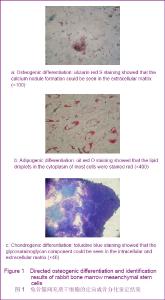
2.1 兔骨髓间充质干细胞的定向分化鉴定 在成骨诱导培养液的诱导分化条件下,7 d就可检测到向成骨细胞分化的早期特征——碱性磷酸酶的表达;而细胞形态在10 d左右发生改变,细胞体积变大,形态呈类圆形或多边形。诱导21 d时茜素红S染色显示细胞外基质中有钙结节形成,见图1a。在成脂肪细胞培养液的诱导分化条件下,细胞形态在诱导3 d左右出现形态改变,10 d时可在相差显微镜下观察到细胞质中发亮的脂滴,随着诱导时间的延长,脂滴变大、增多,脂肪样细胞也逐渐增多。诱导21 d时油红O染色结果多数细胞的细胞质中的脂滴都被染成红色,见图1b。在成软骨细胞培养液的诱导分化条件下,细胞团在三维的培养体系中体积无明显变化,随着诱导时间增加,细胞团逐渐表现更加致密。而未加诱导的细胞团则在培养第2天就缩小,并在第1次换液时被吹散成松散的细胞团,第2次换液时则被完全吹散成细胞悬液。诱导21 d时收获细胞团,40 g/L多聚甲醛固定,石蜡包埋切片,甲苯胺蓝染色结果显示细胞内以及细胞外基质中有氨基多糖成分,见图1c。"
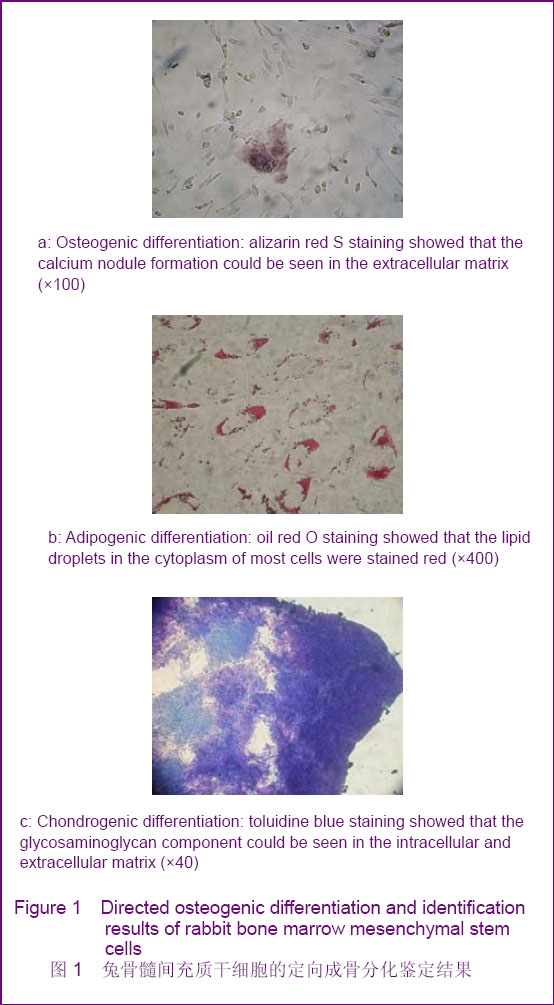
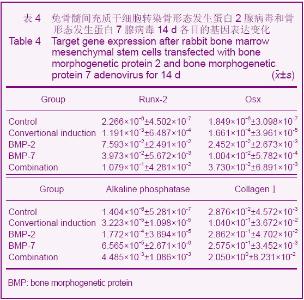
转染第7天,联合转染组Runx-2、Osx、Ⅰ型胶原和碱性磷酸酶mRNA表达,均较其他各组明显增高 (P < 0.05);2个腺病毒转染组上述成骨相关基因mRNA表达均较空白组和常规诱导组增高(P < 0.05);而BMP-2腺病毒转染组Runx-2和碱性磷酸酶mRNA表达水平高于BMP-7腺病毒转染组(P < 0.05);Osx和Ⅰ型胶原mRNA表达水平低于BMP-7腺病毒转染组(P < 0.05)。转染第14天,结果与第7天相似,联合转染组Runx-2、Osx、Ⅰ型胶原和碱性磷酸酶mRNA表达均较其他各组明显增高(P < 0.05);同时,4个检测指标基因mRNA表达第14天均高于第7天(P < 0.05),见表4。"

| [1] Turgeman G, Pittman DD, Müller R,et al.Engineered human mesenchymal stem cells: a novel platform for skeletal cell mediated gene therapy.J Gene Med. 2001;3(3):240-251.[2] Jia TL, Wang HZ, Xie LP,et al.Daidzein enhances osteoblast growth that may be mediated by increased bone morphogenetic protein (BMP) production.Biochem Pharmacol. 2003;65(5):709-715.[3] Knippenberg M, Helder MN, Zandieh Doulabi B,et al.Osteogenesis versus chondrogenesis by BMP-2 and BMP-7 in adipose stem cells.Biochem Biophys Res Commun. 2006;342(3):902-908.[4] White AP, Vaccaro AR, Hall JA,et al.Clinical applications of BMP-7/OP-1 in fractures, nonunions and spinal fusion.Int Orthop. 2007 Dec;31(6):735-741.[5] Bustos-Valenzuela JC, Fujita A, Halcsik E, et al.Unveiling novel genes upregulated by both rhBMP2 and rhBMP7 during early osteoblastic transdifferentiation of C2C12 cells.BMC Res Notes. 2011;4:370.[6] Bandyopadhyay A, Tsuji K, Cox K, et al.Genetic analysis of the roles of BMP2, BMP4, and BMP7 in limb patterning and skeletogenesis.PLoS Genet. 2006;2(12):e216. [7] Koh JT, Zhao Z, Wang Z,et al.Combinatorial gene therapy with BMP2/7 enhances cranial bone regeneration.J Dent Res. 2008;87(9):845-849.[8] Descamps V, Duffour MT, Mathieu MC,et al.Strategies for cancer gene therapy using adenoviral vectors.J Mol Med (Berl). 1996;74(4):183-189.[9] Brody SL, Jaffe HA, Han SK, et al.Direct in vivo gene transfer and expression in malignant cells using adenovirus vectors. Hum Gene Ther. 1994;5(4):437-447.[10] Chen D, Zhao M, Mundy GR.Bone morphogenetic proteins. Growth Factors. 2004;22(4):233-241. [11] Kugimiya F, Ohba S, Nakamura K,et al.Physiological role of bone morphogenetic proteins in osteogenesis.J Bone Miner Metab. 2006;24(2):95-99. [12] Reddi AH.Morphogenesis and tissue engineering of bone and cartilage: inductive signals, stem cells, and biomimetic biomaterials.Tissue Eng. 2000;6(4):351-359. [13] Zhang ZJ,Lu SB,Wang JF,et al.Zhonghua Waike Zazhi.1996; 34(10):596-597.张子军,卢世璧,王继芳,等.骨缺损中内源性BMP的分布及其作用[J].中华外科杂志,1996,34(10):596-597.[14] Cook SD, Wolfe MW, Salkeld SL,et al.Effect of recombinant human osteogenic protein-1 on healing of segmental defects in non-human primates.J Bone Joint Surg Am. 1995;77(5): 734-750. [15] Nishihara A, Fujii M, Sampath TK,et al. Bone morphogenetic protein signaling in articular chondrocyte differentiation. Biochem Biophys Res Commun. 2003;301(2):617-622. [16] Ebisawa T, Fukuchi M, Murakami G, et al.Smurf1 interacts with transforming growth factor-beta type I receptor through Smad7 and induces receptor degradation.J Biol Chem. 2001; 276(16):12477-12480. [17] Miyazono K, Maeda S, Imamura T.BMP receptor signaling: transcriptional targets, regulation of signals, and signaling cross-talk.Cytokine Growth Factor Rev. 2005;16(3):251-263. [18] Ulsamer A, Ortuño MJ, Ruiz S, et al.BMP-2 induces Osterix expression through up-regulation of Dlx5 and its phosphorylation by p38.J Biol Chem. 2008;283(7):3816-3826.[19] de Jong DS, Steegenga WT, Hendriks JM,et al.Regulation of Notch signaling genes during BMP2-induced differentiation of osteoblast precursor cells.Biochem Biophys Res Commun. 2004;320(1):100-107. |
| [1] | Lyu Ruyue, Gu Lulu, Liu Qian, Zhou Siyi, Li Beibei, Xue Letian, Sun Peng. Regulatory mechanisms of exosome secretion and its application prospects in biomedicine [J]. Chinese Journal of Tissue Engineering Research, 2026, 30(1): 184-193. |
| [2] | Xu Canli, He Wenxing, Wang Yuping, Ba Yinying, Chi Li, Wang Wenjuan, Wang Jiajia. Research context and trend of TBK1 in autoimmunity, signaling pathways, gene expression, tumor prevention and treatment [J]. Chinese Journal of Tissue Engineering Research, 2026, 30(在线): 1-11. |
| [3] | Liu Xun, Ouyang Hougan, Pan Rongbin, Wang Zi, Yang Fen, Tian Jiaxuan . Optimal parameters for physical interventions in bone marrow mesenchymal stem cell differentiation [J]. Chinese Journal of Tissue Engineering Research, 2025, 29(31): 6727-6732. |
| [4] | Lin Meiyu, Zhao Xilong, Gao Jing, Zhao Jing, Ruan Guangping. Action mechanism and progress of stem cells against ovarian granulosa cell senescence [J]. Chinese Journal of Tissue Engineering Research, 2025, 29(25): 5414-5421. |
| [5] | Hu Enxi, He Wenying, Tao Xiang, Du Peijing, Wang Libin. Regulation of THZ1, an inhibitor of cyclin-dependent kinase 7, on stemness of glioma stem cells and its mechanism [J]. Chinese Journal of Tissue Engineering Research, 2025, 29(25): 5374-5381. |
| [6] | Tian Zhenli, Zhang Xiaoxu, Fang Xingyan, Xie Tingting. Effects of sodium arsenite on lipid metabolism in human hepatocytes and regulatory factors [J]. Chinese Journal of Tissue Engineering Research, 2025, 29(23): 4956-4964. |
| [7] | Han Fang, Shu Qing, Jia Shaohui, Tian Jun. Electrotactic migration and mechanisms of stem cells [J]. Chinese Journal of Tissue Engineering Research, 2025, 29(23): 4984-4992. |
| [8] | Hu Chen, Jiang Ying, Chen Jia, Qiao Guangwei, Dong Wen, Ma Jian. Preparation and characterization of alendronate/chitosan/polyvinyl alcohol composite hydrogel films [J]. Chinese Journal of Tissue Engineering Research, 2025, 29(22): 4720-4730. |
| [9] | Yang Chao, Luo Zongping. Small molecule drug TD-198946 enhances osteogenic differentiation of rat bone marrow mesenchymal stem cells [J]. Chinese Journal of Tissue Engineering Research, 2025, 29(13): 2648-2654. |
| [10] | Li Xiaofeng, Zhao Duo, Ouyang Qin, Pang Zixiang, Li Yuquan, Chen Qianfen. Protective effect of mangiferin on oxidative stress injury in rat bone marrow mesenchymal stem cells [J]. Chinese Journal of Tissue Engineering Research, 2025, 29(13): 2669-2674. |
| [11] | Hu Zezun, Yang Fanlei, Xu Hao, Luo Zongping. Effect of surface roughness of polydimethylsiloxane on osteogenic differentiation of bone marrow mesenchymal stem cells under stretching conditions [J]. Chinese Journal of Tissue Engineering Research, 2025, 29(10): 1981-1989. |
| [12] | Yang Zhihang, Sun Zuyan, Huang Wenliang, Wan Yu, Chen Shida, Deng Jiang. Nerve growth factor promotes chondrogenic differentiation and inhibits hypertrophic differentiation of rabbit bone marrow mesenchymal stem cells [J]. Chinese Journal of Tissue Engineering Research, 2025, 29(7): 1336-1342. |
| [13] | Huang Ting, Zheng Xiaohan, Zhong Yuanji, Wei Yanzhao, Wei Xufang, Cao Xudong, Feng Xiaoli, Zhao Zhenqiang. Effects of macrophage migration inhibitory factor on survival, proliferation, and differentiation of human embryonic stem cells [J]. Chinese Journal of Tissue Engineering Research, 2025, 29(7): 1380-1387. |
| [14] | Liu Haowen, Qiao Weiping, Meng Zhicheng, Li Kaijie, Han Xuan, Shi Pengbo. Regulation of osteogenic effects by bone morphogenetic protein/Wnt signaling pathway: revealing molecular mechanisms of bone formation and remodeling [J]. Chinese Journal of Tissue Engineering Research, 2025, 29(3): 563-571. |
| [15] | Wang Zhikun, Bai Shaoxuan, Zhao Wei, Wang Chenyu. Exercise preconditioning combined with bone marrow mesenchymal stem cell transplantation for myocardial infarction in rats [J]. Chinese Journal of Tissue Engineering Research, 2025, 29(1): 65-73. |
| Viewed | ||||||
|
Full text |
|
|||||
|
Abstract |
|
|||||
